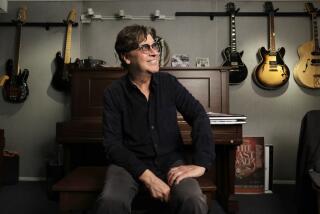POP MUSIC REVIEW : Lombardo Band Brings Back Memories of Note
- Share via
IRVINE — Some shows are memorable on their own merits.*
Others are memorable for the memories they stir. The latter was the case Sunday afternoon when the late Guy Lombardo’s band, the Royal Canadians, directed by keyboardist-singer Al Pierson, played a nostalgia-filled concert that included appearances from singer Gary Crosby and the Pied Pipers vocal group.
The show’s effect, though not stunningly musical, was that of a giant time warp that leaked the sounds and emotions of 40, 50 and 60 years ago and spilled them into the present.
That’s not to say there weren’t fine, though predictable, musical moments.
The Pipers--Bobbi Boyle, Dick Castle, Jay Meyer and Joe Eich--combined on the kind of honeyed, four-part harmonies that have inspired such groups as the Manhattan Transfer. It’s a safe bet that there were few in the audience who didn’t recognize every tune the Pipers crooned--”The Sunny Side of the Street,” “I Should Care,” “I’ll Never Smile Again,” the group’s theme “Dream”--and each chestnut was treated with grace and respect. Castle’s between-song patter only increased the nostalgic feel.
Lombardo’s orchestra, which opened the show, operated in the same vein, with Pierson adding historical tidbits before and after each tune. Here it was the sound that was familiar, with its creamy blend of alto saxophones, tenor, baritone trombone and dual trumpets that seemed to float over the simple rhythm section fare.
The genius of Lombardo’s arrangements was (and is) not their complexity--everything is laid out simply and with a predictable inevitability--but in the various orchestrations and undemanding counterpoints that come from the seven-piece horn section.
*
Again and again on such tunes as “Sentimental Journey,” “Seems Like Old Times” (both particularly apt in this setting) and “Boo Hoo,” the band mixed and matched instrumental combinations. At times, the saxes took the lead, then handed off to the trumpets. Other times, muted trumpet and trombones worked delicate lines, while the saxes responded in conservative fashion. There were moments when two, three or all of the saxophonists would exchange their instruments for clarinets, often just to add the briefest embellishment. The result was a varied tonal palette, smeared with enough color to impress van Gogh.
The same criticism aired against the band in its heyday--that it didn’t swing--was beside the point here. With the rhythms mainly paced by the gentlest of high-hat cymbal tapping, the horns would lift above the beat, almost suspended in a simple, melodic way. It was this approach, along with those unique orchestrations, that defined the Lombardo band, and Sunday’s performance was absolutely true to that tradition.
Indeed, this band, with a half-dozen young faces, could swing when called upon, as proven by its work behind the Pied Pipers. But even this was unambitious by today’s standards, with only the occasional hard rhythmic hint coming from pianist Fred Norman or the horns as conducted by lead alto player Bob Edmonds.
The least satisfying moments came from Crosby, son of the famous singer, who had a fling with vocal stardom himself after recording “Sam’s Song” with his father in 1950. Wearing a tux, eyeglasses and an earring, Crosby recalled the composers who traveled through his childhood home--Johnny Mercer, Hoagy Carmichael--with a tune or two from each.
His delivery was hampered by a narrow range and a lack of strength on higher pitches. At times, it seemed there was only one tone he could hit well, while he disguised the rest with slides, vibrato and other stylistic tricks.
He was at his best (even though he dropped a line and had to wait for the band to catch up) during “The Downtown Polker Club,” a rap popularized by Phil Harris. Crosby was able to talk his way through, rather than sing, and his rhythmic smarts were readily apparent.
More to Read
The biggest entertainment stories
Get our big stories about Hollywood, film, television, music, arts, culture and more right in your inbox as soon as they publish.
You may occasionally receive promotional content from the Los Angeles Times.









